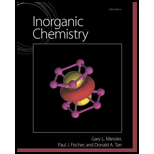
a. Obtain a representation based on all the motions of the atoms in
b. Reduce this representation to its component irreducible representations.
c. Classify these representations, indicating which are for translational, rotational, andvibrational motion.
d. Determine the irreducible representation matching the xenon—oxygen stretching vibration.Is this vibration IR active?
Trending nowThis is a popular solution!
Learn your wayIncludes step-by-step video

Chapter 4 Solutions
Inorganic Chemistry
Additional Science Textbook Solutions
Organic Chemistry (9th Edition)
Chemistry: Structure and Properties
Organic Chemistry
General, Organic, and Biological Chemistry (3rd Edition)
Chemistry: A Molecular Approach (4th Edition)
Chemistry: Structure and Properties (2nd Edition)
- The molecular ion HeH+ has an equilibrium bond length of 0.774 Å. Draw an electron correlation diagram for this molecule, indicating the occupied MOs. If the lowest energy MO has the form C11sH+C21sH , do you expect C2 to be larger or smaller than C1 ?arrow_forwardFollowing the pattern of Figure 6.21, work out the correlation diagram for the CN molecule, showing the relative energy levels of the atoms and the bonding and anti-bonding orbitals of the molecule. Indicate the occupation of the MOs with arrows. State the order of the bond and comment on the magnetic properties of CN.arrow_forward3. jẩsẩeẩajch molecule or ion to its proper point group. a. XeO6 (perxenate) b. BRF5 c. j ẩtjhroline d. cyclopentadienyl anionarrow_forward
- A molecular orbital electron configuration includes a portion that is written as (30, 2p)1. Match the various parts of this notation with their meaning. the first number, "3" the label "o" the label "u" the superscript "1" A. the number of electrons occupying the molecular orbital B. an index that indicates the energy shell of the parent atomic orbitals C. the parity of the molecular orbital (relative to inversion) D. the spin multiplicity of the orbitalarrow_forward4. For each of the following molecules: i. Determine the point group. ii. Determine r (red) as a direct sum of irreducible representations for xyz motion of each atom in the molecule. ii. Determine I (vib) as a direct sum of irreducible representations for molecular vibrations. a. þ,F, b. ХeFsarrow_forwarde. What are the characters for the irreducible representations for E"? f. If one O atom is placed in a D3h point group, what is the Mulliken symbol for its px orbital? g. If an Co²+ ion is placed in a D3h point group, what is the Mulliken symbol for its dxz orbitals? 4. One application of the Group Theory in chemistry is to predict vibrational modes of a molecule. For example, Mn(CO)5Cl (shown below) only gives one IR band. By answering the following questions, you will be able to understand why this is the case. OC-Mn- СО OC a. What is the point group of this molecule? b. Copy the Character Table for the identified point group from your textbook (Appendix C) here.arrow_forward
- 11. What is Electromagnetic radiation? 12. What are the conditions for a molecule to be Raman active?arrow_forwardDiatomic molecules. The order of stability of molecular orbitals a) It is always the same for all b) It is almost the same as that of the starting atomic orbitals c) It follows from the appropriate correlation diagrams d) It is known exactly quantitatively.arrow_forward4. The following phosphorous halide molecules contain P as the central atom. i. Draw the expected molecular shape, determine whether it is polar, and indicate the overall direction of the dipole moment. (You do NOT need to show resonance or formal charges AND if there are more than one isomer, please pick one for your answer. ii. List all its symmetry elements and show all unique symmetry elements that are not the identity operator or an improper rotation. ii. Determine its point group. d. PCI3BR2 е. PCI,Br2larrow_forward
- Using group theory and the stretching mode of CO, predict how many IR active vibrational modes you should have for A. Mo(CO)6 and B. (1,3,5-C6H3(CH3)3)Mo(CO)3arrow_forwardFor this problem, the molecular orbitals of vitamin C are represented as thick lines. It takes light with a wavelength of 256 nm to cause an electron transition from the HOMO to the LUMO. a. On the diagram, label the HOMO and LUMO. b. If we want the electron to jump from the HOMO to an empty orbital that's higher than the LUMO, should we use light with a wavelength greater than 256 nm or less than 256 nm? (Choose one.) c. To the right of the arrow, draw the thick MO lines and "fishhooks" we would get after performing the big jump from part b. || ++ lightarrow_forward4. Describe an object in nature (not a molecule or ion!) whose symmetry corresponds to each of the following point groups, and give a brief explanation why. а. С, b. C2v C. D4harrow_forward
 Principles of Modern ChemistryChemistryISBN:9781305079113Author:David W. Oxtoby, H. Pat Gillis, Laurie J. ButlerPublisher:Cengage Learning
Principles of Modern ChemistryChemistryISBN:9781305079113Author:David W. Oxtoby, H. Pat Gillis, Laurie J. ButlerPublisher:Cengage Learning Physical ChemistryChemistryISBN:9781133958437Author:Ball, David W. (david Warren), BAER, TomasPublisher:Wadsworth Cengage Learning,
Physical ChemistryChemistryISBN:9781133958437Author:Ball, David W. (david Warren), BAER, TomasPublisher:Wadsworth Cengage Learning, Organic Chemistry: A Guided InquiryChemistryISBN:9780618974122Author:Andrei StraumanisPublisher:Cengage Learning
Organic Chemistry: A Guided InquiryChemistryISBN:9780618974122Author:Andrei StraumanisPublisher:Cengage Learning


